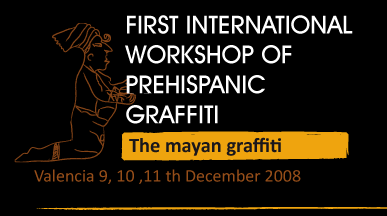
The incised or painted representations on plaster walls, most commonly known as graffiti, are very frequent inside Mayan buildings. Nevertheless, there have been few studies that analyze the intricacy and history of these drawings, even though they are often mentioned by explorers and researchers who have been visiting the ancient Maya sites since the 19th century and the many archaeological projects from the past few decades.
Nevertheless, a large amount of this graffiti has already been destroyed, due to the fact that, when they were discovered, the suitable measurements of protection and conservation were not taken into account. This a lamentable loss for the history of the Mayan art, as these kinds of expressions constitute a prime source to approach not only to the complex world of the Mayan beliefs but also to enter in the lives and customs of those who inhabited these buildings in the ancient times.
In this first International Workshop dedicated to the Mayan graffiti, some of the last graffiti discoveries and investigations from Mexico and Guatemala will be presented. There will be discussions about the application of the most adapted methodologies for their study and their conservation, and scientific diffusion will be promoted



15:00-16:00 h. Workshop registration.
16:00-16:30 h. Workshop presentation. Cristina Vidal Lorenzo (Universidad de Valencia).
16:30-17:15 h. The graffiti of Rio Bec, Mexico. Julie Patrois and Philippe Nondédéo (CNRS-Paris).
17:15-17:45 h. Coffee break.
17:45-18:30 h. Ornamentation, location and meaning of Comalcalco's decorated bricks, Tabasco, Mexico. M.Judith Gallegos Gómara and Ricardo Armijo Torres (INAH, Centro Tabasco).
18:30-19:15 h. The graffiti of Chichen Itza. A particular case in the North of Yucatan. Peter Schmidt and Ana M. Martín (INAH-Yucatán and Universidad Complutense de Madrid).
19:15-20:00 h. Round table. Chairman: Dominique Michelet (CNRS-Paris).

10:00-10:45 h. The Mayan graffiti and their entail with the archaeological record. Ricardo Torres Marzo (Universidad de Valencia) and Mª Luisa Vázquez de Ágredos (Universidad Politécnica de Valencia).
10:45-11:30 h. The Mayan graffiti of Nakum and Yaxha, Guatemala. Their archaeological, architectural and iconographic context. Jaroslaw Zralka (University Jagiellonica) and Bernard Hermes (IDAEH-Guatemala).
11:30-12:00 h. Coffee break.
12:00-12:45 h. The graffiti of La Blanca, Guatemala (I). Investigations about materials, process and techniques. Begoña Carrascosa Moliner, Montserrat Lastras Pérez and Francisca Lorenzo Mora (Universidad Politécnica de Valencia).
12:45-13:30 h. The graffiti of La Blanca, Guatemala (II). Methodology for their study and artistic interpretation. Cristina Vidal Lorenzo (Universidad de Valencia) and Gaspar Muñoz Cosme (Universidad Politécnica de Valencia).
13:30-14:15 h. Round table. Chairman: Miguel Rivera Dorado (Universidad Complutense de Madrid).
16:30-19:30 h. Guided Visit to the Historical Center of Valencia.

10:00-11:30 h. Working session: Putting a value on Mayan graffiti.
11:45-12:15 h. Coffee break.
12:15-14:00 h. SWorking session: Proposal of the creation of a website for the scientific diffusion of the Mayan graffiti.
14:00-14:30 h. Results and conclusions of the working sessions. Chairman:
Gaspar Muñoz Cosme (Universidad Politécnica de Valencia).

 Vicerrectorado de Investigación y Política científica de la Universidad de Valencia Consellería de Educación de la Generalitat Valenciana Forum UNESCO |
 Cristina Vidal Lorenzo (UV) Gaspar Muñoz Cosme (UPV)  Núria Feliu Beltrán (UV) |
Secretaría del workshop
Departamento de Hª del Arte
Facultad de Geografía e Historia
Avda. Blasco Ibáñez, 28
46010 Valencia
Tel: + 34 963 983 330
Fax + 34 963 864 496
Nuria.Feliu@uv.es

Lugar de celebración
Colegio Mayor Rector Peset
Plaza del Horno de San Nicolás, 4
46001 Valencia
Tel: +34 963 166 000

www.uv.es/artemaya
